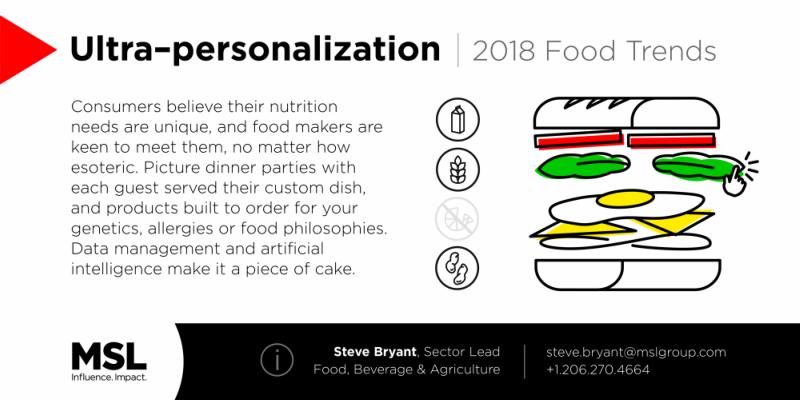MSL 29 Sep 2017 // 4:57PM GMT

Even as the boundaries of public relations are redrawn, earned influence continues to reign supreme as the industry’s most enduring, valued output. Yet one of the industry’s most stubborn challenges is the limitation of influence: a short shelf-life restricted by the publisher's reach, the influencer's power, the time frame in which it appears, and imprecise audience targeting.
Recognizing the need to better leverage and quantify how earned influence drives results (sales, behavior change and reputation lift), MSL built Conversation2Commerce. Using a patent-pending software, content is instantly converted into a new ad format — Earned Content Units. From there, an ECU is targeted and scaled to the precise right person programmatically or via other paid solutions. This allows C2C to accelerate the consumer journey by ensuring the right person sees the right content at the precise right time, ultimately giving the C2C experts several avenues to link the earned content to e-commerce, store sales, brand preference and other measurable business impacts.
We spoke to Erin Lanuti, Chief Influence Strategist at MSL about this groundbreaking performance platform — and how it calibrates to the constantly changing media and Influence landscape where things like fake news are delivering new challenges for credibility and brand reputation.
Q: Let’s first talk about the power of influence because this the foundation for Conversation2Commerce and Conversation2Crediblity. While brand storytelling is more popular than ever, it seems third-parties still have the most influence on purchase decisions and brand perceptions?
Erin Lanuti: As people move online to social media and e-commerce, their online habits begin to reveal new habits. We now always look at ratings and reviews, even though these points of view usually come from complete strangers. There’s been considerable research that shows that people trust strangers today, sometimes even more than people they know! This trust has grown out of e-commerce, the overall growth of social channels and people’s increasing comfort with sharing their experiences online. If you look at the value of influence versus paid media — dollar for dollar — the influencer campaign gives you roughly $6 in return.
Q: As part of that, it seems there’s been a democratization of opinion. Would you say the average consumer seems to hold as much clout as professional critics now?
Lanuti: They both hold clout but the amount varies based on category, context and where someone is in their purchase journey. We’ve been testing this across a few categories and measuring against paid media performance, e-commerce and brand lift studies. What we see is there is no one-size-fits-all answer. We’ve seen a relatively unknown influencer drive more brand consideration and preference than a national publication and in other categories a national publisher’s weight drives considerably more sales than consumer ratings and reviews.
Q: Let’s talk more about ‘known influencers.’ Unlike traditional journalists, influencers don’t always operate in a totally earned capacity and commonly have commercial partnerships with the brands they work with. How is C2C designed for this type of content that blurs lines.
Lanuti: We look at all influence — this can be earned, organic or paid content. But paid influencers are starting to become a problem for brands, especially in categories like beauty. You’ll have an influencer talking about brand A one day, then brand B the next day. Brands are getting frustrated because this dilutes the influencer’s credibility and influence. It is an increasing problem for influencer marketing as a whole. We are working on a solution for this that we hope to launch by the year’s end..
Q: Speaking of platforms, can you explain how Conversation2Commerce measures, scales and targets influence?
Lanuti: Sure. I’ll start by sharing that we had a big learning within four months of launching the platform. We thought as PR practitioners, we could — almost instinctively — select the best, most influential pieces of earned content. But when we ran the earned content through our own Earned Plan Lab, it didn’t perform well. The Earned Plan Lab uses a decades old discreet choice marketing methodology and applies it to earned media. The results were really eye-opening and caused us to build what we call our Earned Content Criteria. We now analyze all the content that goes into Conversation2Commerce against it. Since we’ve been doing this, we get twice the brand lift and sales on the qualified content. It’s made such a big impact with one of our largest clients, that it has become part of the media relations protocols for all the content we secure for them.
Q: Can you share a bit more about the type of content that performs so well?
Lanuti: It varies on the context, but for instance, the headline matters more than people even think. You need the brand and its key differentiators or messages mentioned as high up as possible in content because people have very short attention spans. Where possible, having the brand name in the headline is ideal. We’ve also just conducted a neuro-science study to better understand how people react to different types of content – brand ads, earned ads, articles, videos and influencer videos. There were some really interesting insights in the study which we’ve published on our site publicisc2c.com.
Q: This is totally counter to the industry’s obsession with impressions.
Lanuti: It’s a higher bar. You can say that you got a billion impressions, but what’s the true impact of it? We need to be creating content that is relevant, engaging and drives a business impact. If there’s a piece of content that was written and has a disproportionate amount of shares and we’re seeing purchases from that content, then it should do that much better if we scale and target it. We are obsessed with understanding how and why certain content, influencers and pieces of influence deliver a measurable business impact. This is a core element of what sets Conversation2Commerce apart.
Q: How is this different from what’s already out there, like content syndication?
Conversation2Commerce is an end-to-end influence to impact performance platform. We start at the strategy phase and then work collectively to identify, pitch, secure and qualify the most relevant influence. Once secured, we then work across all paid, owned, earned and shopper channels to ensure we target and scale the content to the precise right person at the right time in their journey to deliver a measurable business impact. We do this both online and offline as well as increasingly in partnership with e-commerce platforms.
Because C2C lives in a constant state of beta, we are finding new uses for it every day. To learn more about C2C, please visit http://www.publicisc2c.com/.



































.jpg)















